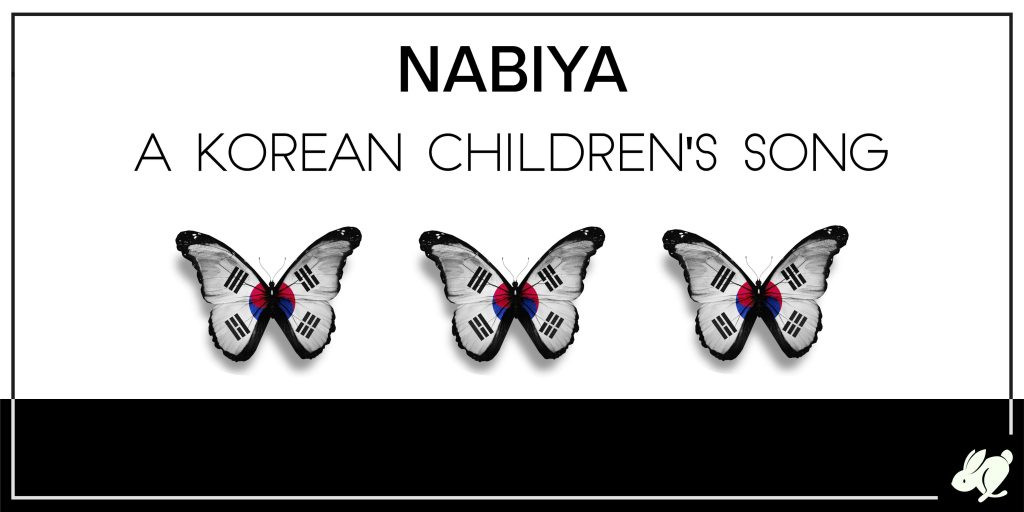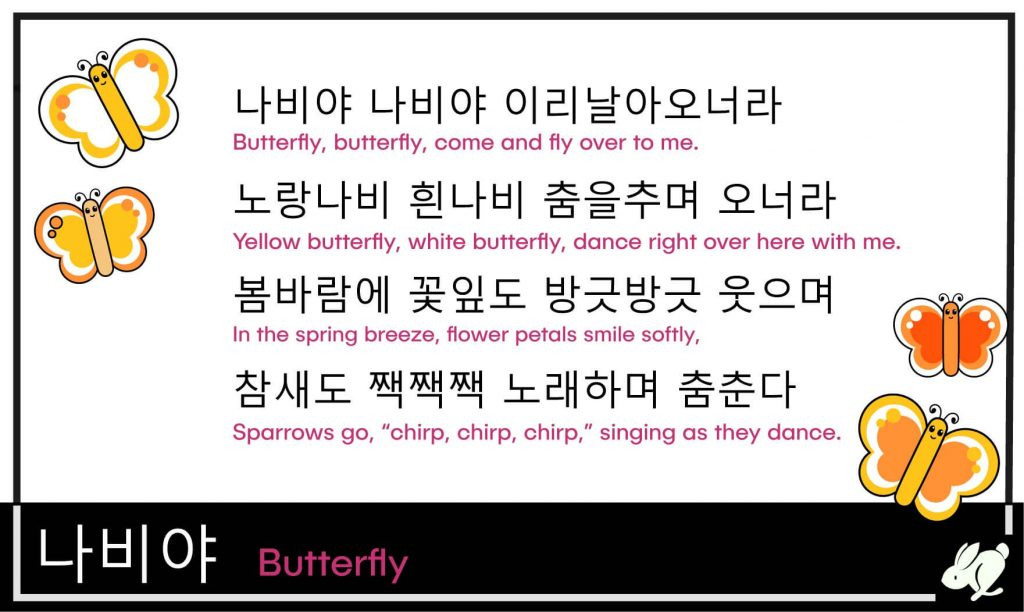“Nabiya” is a cherished children’s song, deeply ingrained in Korean culture, much like “Twinkle, Twinkle Little Star” resonates in English-speaking countries. For many, learning “Nabiya” feels almost instinctive; it’s a melody often encountered in childhood, frequently sung by mothers and a staple in beginner piano books throughout Korea. The word “Nabi” translates to “butterfly,” but it also carries a sweet nuance as a term of endearment, particularly for cats. Reflecting on childhood pets, many Koreans fondly recall calling their feline companions “Nabi.”
 Nabiya Korean butterfly song header image, featuring the song title in Korean and English with butterfly imagery.
Nabiya Korean butterfly song header image, featuring the song title in Korean and English with butterfly imagery.
Understanding Korean Honorifics in “Nabiya”
The title “Nabiya” itself offers a glimpse into Korean linguistic nuances. The addition of “ya” to “Nabi” (butterfly) is a form of informal honorific. In Korean, appending “yah” or “ah” to a name softens it, creating a familiar and affectionate tone when addressing someone – or even a beloved animal. It’s a gesture of closeness, less formal than using just the name alone, indicating a comfortable familiarity. Parents often use this honorific when calling their children, adding a touch of tenderness to their address.
“Nabiya” Lyrics: A Song of Spring and Nature
“Nabiya” is an especially delightful song to introduce during springtime, particularly when children are learning about the life cycle of butterflies. Imagine elementary students releasing butterflies nurtured from cocoons, accompanied by this gentle melody. The lyrics paint a simple yet vivid scene: a wish for butterflies to flutter nearby, flowers smiling in a gentle breeze, and sparrows singing sweetly. The English translation aims to capture the essence and syllable count of the original Korean, ensuring it harmonizes beautifully with the melody.
 Lyrics for the Korean children's song Nabiya, displayed in both Korean and an adapted English translation.
Lyrics for the Korean children's song Nabiya, displayed in both Korean and an adapted English translation.
Musical Simplicity of “Nabiya”: Perfect for Beginners
The musical structure of “Nabiya” explains its popularity in beginner piano method books. The rhythm is built upon quarter and eighth notes, creating a comfortable and predictable flow. The melody gracefully moves within the first five notes of a musical scale, making it easy for young voices and instruments. With just two chords forming its harmonic foundation, “Nabiya” is wonderfully accessible for accompaniment on guitar and ukulele, inviting children to explore music-making.
Fun Movements to Accompany the Butterfly Song
Incorporating movements enhances the joy and engagement when singing “Nabiya.” Here are some suggested actions that bring the song to life:
| Measures | Movement |
|---|---|
| 1-8 | Mimic butterfly flight with any motion – fluttering fingers with joined thumbs or graceful arm movements. |
| 9-10 | Create a gentle breeze by swaying arms from side to side, embodying the swaying flowers. |
| 11-12 | Frame your face as a blossoming flower by placing wrists together under your chin, hands acting as petals. This movement is a traditional accompaniment to the song. |
| 13-14 | Use hands like playful puppets to represent chirping sparrows, bringing a lively element to the song. |
| 15-16 | Repeat the swaying breeze motion from measures 9-10, reinforcing the gentle imagery. |
Explore “Nabiya” Further: Video Resources
To deepen your understanding and enjoyment of “Nabiya,” several video resources are available. The first video provides clear pronunciation guidance, essential for accurate singing. The second video offers an adorable performance, showcasing creative interpretations of the melody and embellished movements, inspiring further engagement with the song.
Extend the Learning: Activities Related to “Nabiya”
For educators seeking to expand lessons around “Nabiya,” a fun Boom Cards flashlight game offers an interactive experience. Students embark on a virtual journey through Korean landscapes, using a flashlight to discover hidden butterflies. Upon finding a butterfly, they are rewarded with the song, creating a playful learning loop. For those interested in exploring more Korean children’s songs, resources like blog posts on “Santoki” and “Ha’kyo Jung” offer further musical adventures into Korean culture.
“Nabiya,” with its simple beauty and cultural richness, is more than just a song; it’s an invitation to explore music, language, and nature’s gentle wonders.

